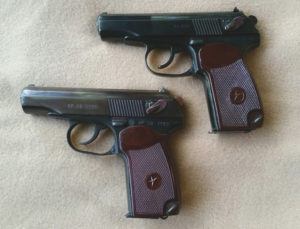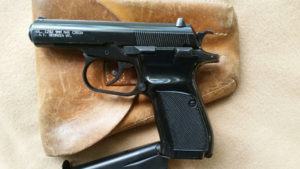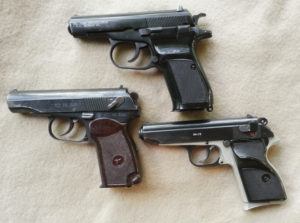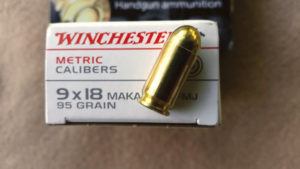
- The Makarov 9mm is a Russian-designed double-action, straight blowback pistol.
- The 9x18mm Makarov cartridge is distinct from the 9mm Luger, uses an odd-sized .365-inch bullet.
- Russian Makarov imports lasted only a few short years due to the Clinton import ban.
- Bulgarian Makarov copies are available on the surplus market and are a good find.

History of the Makarov 9mm
Manufactured at Russia’s Izhevsk factory, the Pistolet Makarova — Makarov 9mm — was the brainchild of Nikolai Fyodorovich Makarov, who designed his new double-action, straight blow-back pistol around the proven Walther PP/PPK series of pistols.
After World War II, the Russians had access to the Walther factory in Germany and shipped much of its tooling back to the USSR.
Nikolai Makarov opted for a cartridge developed by Boris Semin, who in 1946 developed it from the older Walther 9mm Ultra, an experimental cartridge originally intended for the Luftwaffe. Christened the 9x18mm Makarov, its bullet diameter is an odd .365-inch unlike the typical .355-inch of the 9mm Luger and the .380 ACP (9mm Browning).
The idea behind it was in the case of a supposed contingency where stocks of 9mm Makarov ammunition might be captured by an enemy, that the cartridge could not be used in standard 9mm Luger pistols.
The Makarov semi-automatic pistol incorporates many features of the Walther in that it disassembles identically by grasping the triggerguard, bringing it downward, and pulling back the slide and upward to disengage it from the frame.

Additionally, its double-action safety features are similar in that a cartridge can safely be carried in the chamber with the hammer down. With the hammer at full cock, thumbing the manual de-cock safety upward allows the hammer to fall and subsequently blocks the loaded chamber by use of a transfer bar on the safety, preventing contact with the firing pin.
The eight-shot, medium-weight pistol with its 3.68-inch barrel uses a single screw in its assembly to secure the rear fastened grip. The checkered red Bakelite grips also have a circled star in the center. Markings on the Russian Makarov 9mm are the serial numbers on the left slide flat and frame with a Cyrillic prefix, and the year of manufacture is at the rear of the left frame.
Russian Makarov 9mm Importation
It is important to reiterate that importation of the Russian Makarov lasted but a few short years between 1992 and 1995 due to the eventual trade restriction on Russian military imports during the Clinton administration. Soon after, this also included military arms from China as well.
Ironically, a number of Russian-made Makarov 9mm pistols inadvertently entered the United States between 1998 and 2009 and have become known as the “sneak” Makarovs.
These pistols were imported from Bulgaria and East Germany and were marked with the country of origin, as each of these nations obtained a quantity of the Russian-made versions in the 1970s and ‘80s as supplementary arms to make up for shortages in their ordnance inventories.
Apparently, some of these Russian versions were mixed in and marked with the aforementioned two countries as the origin of manufacture until close BATFE inspection revealed the Russian Izhevsk Triangle cartouche on some of the pistols. These are rather desirable on the collector’s market because of this import marking error.

Regarding licensed Eastern European versions of the Makarov, East Germany was the first of the Soviet satellites to manufacture them, beginning in 1958.
Made at the Ernst Thaelmann State Factory, the first two years of production saw some difficulties in getting off the ground, with full-scale manufacture underway by late 1959 and early 1960.
In the United States, the East German Makarov has become one of most highly sought of their ilk given the beautiful dark blued, smooth finish, coupled with jet-black checkered plastic grips.
The East German pistols also have their internal parts marked by electro pencil with the last two digits of the serial number.
Production ceased in 1965. It appears that those with small, unobtrusive import marks together with condition, determine the higher price and overall desirability.
Bulgarian Makarov
The final licensed Makarov in communist Europe was the Bulgarian version. Given the green light for licensing rights in 1970, few were produced until five years later. Actual production took place at the Friedrich Engels Machine Works — known also as “Factory 10.”
The Soviets supervised and trained the Bulgarians to manufacture the Makarov, and remained in charge of all production throughout 1975.

The next year saw the Bulgarians assume control, and they steadily continued production of the Makarov up to 2007, some 15 years after the fall of communism.
Prior to their sale on the U.S. surplus market, Bulgaria sold quantities of Makarov pistols to Slovenia, well past the communist break up. Most from this country were imported to the U.S. following Bulgaria’s and Slovenia’s admission to NATO in 2004.
Identical to the Russian version with the checkered, red Bakelite grips with a circled star along with the Russian dark blue finish, the Bulgarian Makarov is unquestionably a high-quality copy that prior to 1975 used some Russian internal components until the factory became entirely self-sufficient
Marked with an encrypted prefix for the production year, and followed by the serial number on the left slide and frame, quick identification of the Bulgarian variant is the presence of the Circle 10 stamped on the left frame. Surplus Bulgarian Makarov pistols are still available as of this writing from some U.S. distributors.
Editor’s Note: This excerpt is from the article, “Pistols From Behind the Iron Curtain,” which appeared in the Gun Digest 2018 annual.

Next Step: Get your FREE Printable Target Pack
Enhance your shooting precision with our 62 MOA Targets, perfect for rifles and handguns. Crafted in collaboration with Storm Tactical for accuracy and versatility.
Subscribe to the Gun Digest email newsletter and get your downloadable target pack sent straight to your inbox. Stay updated with the latest firearms info in the industry.

![Best Concealed Carry Guns In 2025 [Field Tested] Wilson Combat EDC X9S 1](https://gundigest.com/wp-content/uploads/Wilson-Combat-EDC-X9S-1-324x160.jpg)


![Best 9mm Carbine: Affordable PCCs [Tested] Ruger Carbine Shooting](https://gundigest.com/wp-content/uploads/Ruger-Carbine-Shooting-100x70.jpg)
![Best AR-15: Top Options Available Today [Field Tested] Harrington and Richardson PSA XM177E2 feature](https://gundigest.com/wp-content/uploads/Harrington-and-Richardson-PSA-XM177E2-feature-100x70.jpg)
